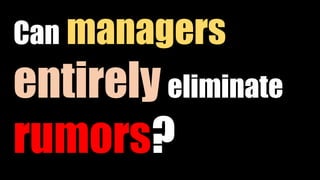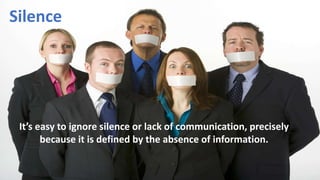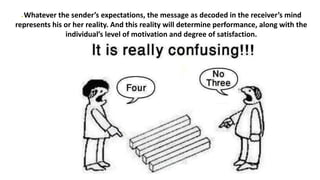ESL 0845L-OL Week 8 a organizational communication
- 2. Poor communication is probably the most frequently cited source of interpersonal conflict. Because individuals spend nearly 70 percent of their waking hours communicating—writing, reading, speaking, listening—it seems reasonable that one of the biggest inhibitors of group performance is lack of effective communication.
- 3. Communication is central to the existence of the organization.
- 4. There is the communication towards the clients (external) and communication towards the employees (internal)
- 5. What did you do this morning?
- 6. Did your alarm wake you up?
- 10. We are surrounded by brands, by organization communication that influence our daily habits (External Communication)
- 11. Advertising is a marketing strategy of communication with the users of a product or service. Advertisements are messages paid for by those who send them and are intended to inform or influence people who receive them.
- 12. Communication involves more than the physical act of exchanging messages. Communication is a complex process that also includes creating and interpreting messages.
- 13. Formal organizational networks can be very complicated, including hundreds of people and a half-dozen or more hierarchical levels.
- 14. It’s frequently assumed rumors start because they make good gossip.
- 16. What they should do, however, is minimize the negative consequences of rumors by limiting their range and impact. No
- 17. Why do people choose one channel of communication over another—say, a phone call instead of a face-to-face talk?
- 19. Filtering Refers to a sender’s purposely manipulating information so the receiver will see it more favorably. A manager who tells his boss what he feels the boss wants to hear is filtering information.
- 20. Selective Perception The receivers in the communication process selectively see and hear based on their needs, motivations, experience, background, and other personal characteristics.
- 21. Information Overload Individuals have a finite capacity for processing data. When the information we have to work with exceeds our processing capacity, the result is information overload. We’ve seen that dealing with it has become a huge challenge for individuals and for organizations.
- 22. Emotions You may interpret the same message differently when you’re angry or distraught than when you’re happy.
- 23. Language Even when we’re communicating in the same language, words mean different things to different people. Age and context are two of the biggest factors that influence such differences.
- 24. Silence It’s easy to ignore silence or lack of communication, precisely because it is defined by the absence of information.
- 25. Employee silence means managers lack information about ongoing operational problems. And silence regarding discrimination, harassment, corruption, and misconduct means top management cannot take action to eliminate this behavior.
- 26. Communication Apprehension An estimated 5 to 20 percent of the population suffers debilitating communication apprehension , or social anxiety.
- 27. Conclusion
- 28. ● The less distortion, the more employees will receive goals, feedback, and other management messages as intended.This, in turn, should reduce ambiguities and clarify the group’s task.
- 29. ● Whatever the sender’s expectations, the message as decoded in the receiver’s mind represents his or her reality. And this reality will determine performance, along with the individual’s level of motivation and degree of satisfaction.
- 30. ● Finally, by keeping in mind communication barriers such as gender and culture, we can overcome them and increase our communication effectiveness.





























